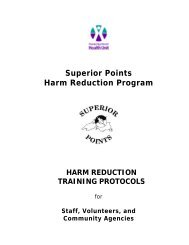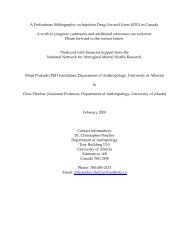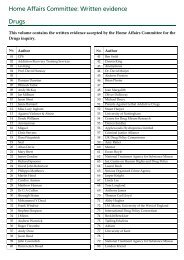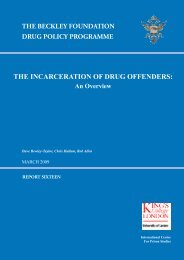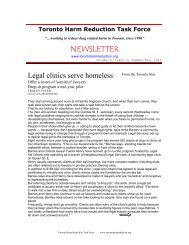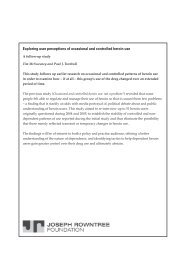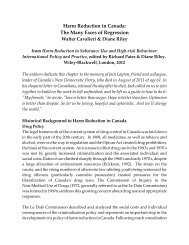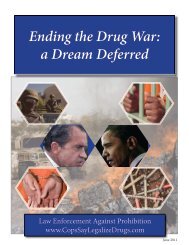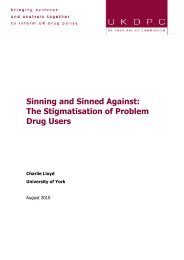and the building of the harm reduction-abstinence ... - ResearchGate
and the building of the harm reduction-abstinence ... - ResearchGate
and the building of the harm reduction-abstinence ... - ResearchGate
You also want an ePaper? Increase the reach of your titles
YUMPU automatically turns print PDFs into web optimized ePapers that Google loves.
S.H. Kellogg / Journal <strong>of</strong> Substance Abuse Treatment 25 (2003) 241–247 245<br />
Tatarsky (1998) has made <strong>the</strong> point that some patients<br />
can learn to moderate <strong>and</strong> control <strong>the</strong>ir use <strong>of</strong> drugs <strong>and</strong><br />
alcohol. Marlatt, Larimer, et al. (1993), in <strong>the</strong>ir review <strong>of</strong><br />
<strong>the</strong> literature, found that controlled drinking was a not uncommon<br />
treatment outcome. Taking this as a possibility,<br />
<strong>abstinence</strong> would still have a role here. Moderation Management,<br />
<strong>the</strong> self-help group dedicated to helping people<br />
control <strong>the</strong>ir alcohol use, asks members to refrain from<br />
drinking for 30 days before beginning a moderation program.<br />
They also ask <strong>the</strong>m to spend that time analyzing<br />
<strong>the</strong>ir patterns <strong>of</strong> use <strong>and</strong> <strong>the</strong> meaning <strong>and</strong> role that alcohol<br />
has for <strong>the</strong>m (Moderation Management, 2003). Marlatt<br />
(Marlatt & Gordon, 1985) also saw <strong>abstinence</strong> as a<br />
preliminary step for those who might be able to moderate<br />
<strong>the</strong>ir use.<br />
However, for <strong>the</strong> gradualist continuum to work, not only<br />
would <strong>the</strong> <strong>harm</strong> <strong>reduction</strong> field have to modify its perspective,<br />
but also <strong>the</strong> treatment community would need to<br />
transform itself as well. A good place to start would be to<br />
bring some <strong>of</strong> this ‘‘welcoming spirituality’’ to <strong>the</strong>ir treatment<br />
facilities, to create <strong>and</strong> foster an atmosphere that is less<br />
harsh <strong>and</strong> less judgmental (Denning, 2001; Marlatt et al.,<br />
2001; Roche et al., 1997; Springer, 2003). This means<br />
<strong>building</strong> on a crucial insight <strong>of</strong> <strong>the</strong> <strong>harm</strong> <strong>reduction</strong> movement—that<br />
healing <strong>and</strong> recovery are more likely to come<br />
through <strong>the</strong> development <strong>of</strong> relationship (Denning, 2001;<br />
Tatarsky, 2003), ra<strong>the</strong>r than through <strong>the</strong> imposition <strong>of</strong><br />
authority. The next step would be to realize that we are<br />
living in a time <strong>of</strong> increasing <strong>the</strong>rapeutic creativity in which<br />
<strong>the</strong>re are more <strong>and</strong> more <strong>the</strong>rapies that are helpful for<br />
addicted or drug-using people. One metaphor that could<br />
illuminate this is <strong>the</strong> idea <strong>of</strong> <strong>the</strong> ‘‘treatment mosaic,’’ an idea<br />
that is essentially synonymous with what is known as <strong>the</strong><br />
treatment menu concept (Miller et al., 1995). A treatment<br />
mosaic would provide patients with a full range <strong>of</strong> <strong>the</strong>rapeutic<br />
possibilities, <strong>and</strong> <strong>the</strong>y would be encouraged to utilize<br />
<strong>the</strong> ones that resonated with <strong>the</strong>m.<br />
In ano<strong>the</strong>r version <strong>of</strong> this argument, Marlatt <strong>and</strong> Kilmer<br />
(1998), <strong>building</strong> on <strong>the</strong> work <strong>of</strong> Bickel (Bickel, Madden,<br />
& Petry, 1998, cited in Marlatt & Kilmer, 1998) have made<br />
<strong>the</strong> case that treatment has <strong>the</strong> potential to be an ‘‘alternative<br />
reinforcer’’ (p. 570) that could replace drug <strong>and</strong> alcohol use.<br />
For this to happen, treatment must be made attractive <strong>and</strong><br />
patients must be treated well. As part <strong>of</strong> <strong>the</strong> process <strong>of</strong><br />
making treatment a positive experience, patients, again,<br />
should be given a range <strong>of</strong> recovery options.<br />
With this in mind, an <strong>abstinence</strong>-oriented healing network<br />
would want to utilize <strong>the</strong> entire range <strong>of</strong> existing <strong>the</strong>rapeutic<br />
approaches that have been shown to have some utility. These<br />
would include <strong>the</strong> full range <strong>of</strong> self-help <strong>and</strong> support groups<br />
including Alcoholics Anonymous, Narcotics Anonymous,<br />
o<strong>the</strong>r twelve-step fellowships, SMART RecoveryR, Rational<br />
RecoveryR, Women (<strong>and</strong> Men) for Sobriety, <strong>and</strong> S.O.S. (see<br />
also Velten’s comments in Marlatt, 1998a, p. 21). In terms <strong>of</strong><br />
psychological interventions for patients, <strong>the</strong>re is relapse<br />
prevention (Marlatt & Gordon, 1985), o<strong>the</strong>r cognitivebehavioral<br />
interventions (Wright, Beck, Newman, & Liese,<br />
1993), psychodynamically-based, addiction-oriented, longterm<br />
psycho<strong>the</strong>rapy (Director, 2002), <strong>and</strong> <strong>the</strong> contingencymanagement<br />
<strong>and</strong> voucher-incentive behavioral programs<br />
(Higgins, Alessi, & Dantona, 2002; Petry, Martin, Cooney,<br />
& Kranzler, 2000; Stitzer, Iguchi, Kidorf, & Bigelow, 1993).<br />
Over <strong>the</strong> past few years, <strong>the</strong>re have been a number <strong>of</strong><br />
interesting <strong>and</strong> creative developments in <strong>the</strong> <strong>the</strong>rapeutic<br />
community field <strong>and</strong>, ideally, <strong>the</strong>se would continue. Clearly,<br />
<strong>the</strong> fur<strong>the</strong>r development <strong>of</strong> <strong>the</strong>rapeutic communities that<br />
incorporate patients who are being treated with methadone<br />
<strong>and</strong> o<strong>the</strong>r maintenance medications would also be a major<br />
breakthrough (De Leon et al., 1995).<br />
There is also a growing literature on <strong>the</strong> ‘‘natural recovery’’<br />
experience that addresses how people recover from<br />
addiction problems without self-help or program attendance<br />
(Biernacki, 1986; Granfield & Cloud, 1996; Stall & Biernacki,<br />
1986), <strong>and</strong> <strong>the</strong> insights from <strong>the</strong>se studies could be<br />
incorporated into treatment. For those who are interested,<br />
religiously based treatment programs may be a possibility<br />
(Muffler, Langrod, Richardson, & Ruiz, 1997). Alternative<br />
medicine <strong>and</strong> holistic health practices may be helpful<br />
adjunctively as well (Nebelkopf, 1981), <strong>and</strong> <strong>the</strong>se could<br />
include acupuncture (Moner, 1996), herbal teas <strong>and</strong> medicines<br />
(Odierna, 2003), <strong>and</strong> yoga (Shaffer, LaSalvia, & Stein,<br />
1997). Ibogaine may also be helpful for some as well<br />
(Alper, Lots<strong>of</strong>, Frenken, Daniel, & Bastiaans, 1999). Lastly,<br />
<strong>the</strong>re are an increasing number <strong>of</strong> medications available to<br />
help support efforts at recovery including methadone (in<br />
adequate doses; D’Aunno & Pollack, 2002; D’Aunno &<br />
Vaughn, 1992), LAAM, buprenorphine/naloxone, naltrexone,<br />
disulfiram, <strong>and</strong> acamprosate.<br />
5. The issue <strong>of</strong> relapse<br />
The final argument in favor <strong>of</strong> <strong>the</strong> gradualist continuum<br />
is <strong>the</strong> high rate <strong>of</strong> relapse among alcohol- <strong>and</strong> drug-dependent<br />
patients. Even <strong>abstinence</strong> advocates like Owen (in<br />
Owen & Marlatt, 2001), believe that only half <strong>of</strong> <strong>the</strong> patients<br />
in alcohol treatment will be likely to achieve sobriety.<br />
O’Brien <strong>and</strong> McLellan (1996), in a paper that strongly<br />
defended <strong>the</strong> efficacy <strong>of</strong> substance abuse treatment, put<br />
<strong>the</strong> treatment success rate for alcohol dependence at approximately<br />
50%, for opioid dependence using methadone<br />
at 60%, <strong>and</strong> for cocaine dependence using a contingency<br />
management protocol, at 55%. (It should be noted that<br />
contingency management, while effective, is not a commonly<br />
used treatment intervention.) They repeatedly stress<br />
that relapse is a commonly occurring phenomenon, <strong>and</strong> that<br />
<strong>the</strong> treatment for substance <strong>and</strong> alcohol dependence should<br />
be considered a long-term endeavor.<br />
The gradualist model being presented here may be able to<br />
respond to this situation. First, by <strong>of</strong>fering a much wider<br />
range <strong>of</strong> options in a positive <strong>and</strong> affirming way <strong>and</strong> allowing<br />
patients to choose among <strong>the</strong>m, <strong>the</strong> treatment field may be




